소개
Stepping into the new era of digital vision, 투명한 LED 디스플레이 화면 are sweeping in with their unique charm!
Whether you are a creative pioneer in the advertising industry, an artistic master of architectural design, or a consumer pursuing the ultimate experience, this article will take you to explore the mysteries of outdoor and indoor transparent LED display screens.
We will directly analyze the core advantages, application scenarios, and unique differences between these two types of display screens so that you can quickly understand how they bring unprecedented changes to commercial publicity, environmental beautification, and information transmission.
1. 3 aspects to quickly understand outdoor transparent LED display screens
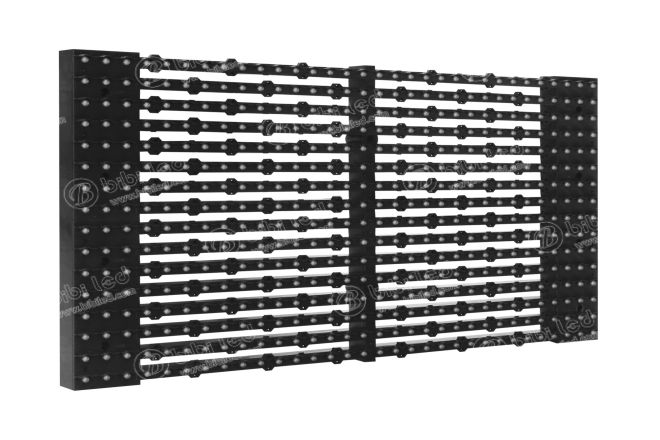
1). 적용 시나리오
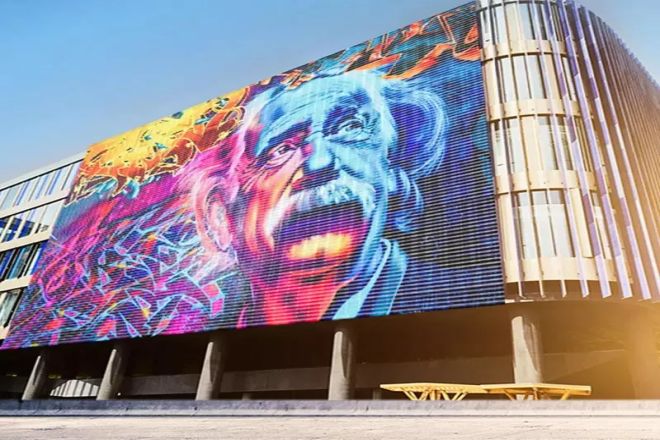
- Exterior walls of large 쇼핑몰:
Outdoor transparent LED display screens are increasingly widely used on the exterior walls of large shopping malls.
They can not only display promotional information and brand advertisements but also maintain the transparency and permeability of the shopping mall building itself so that customers can still feel natural light and outside views while enjoying the fun of shopping.
This design is both practical and beautiful, enhancing the attractiveness of the mall and the customer experience.
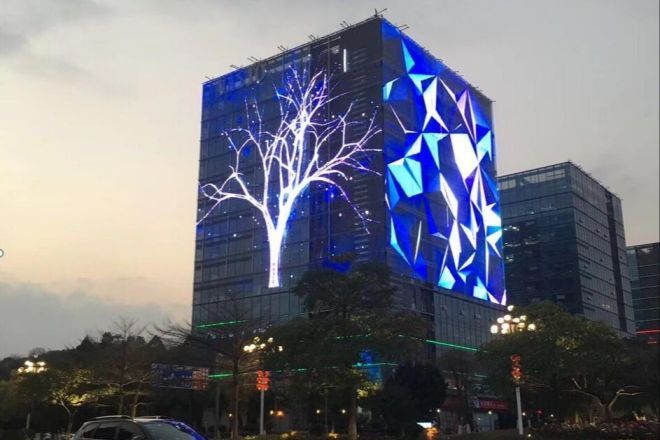
- Landmark buildings:
For landmark buildings in the city, such as high-rise buildings and bridges, installing transparent outdoor LED display screens can be used as a new carrier for information display, artistic expression, or urban lighting.
These displays can shine brilliantly at night, becoming the new business card of the city, attracting tourists to check in, and spreading information such as culture and current affairs.
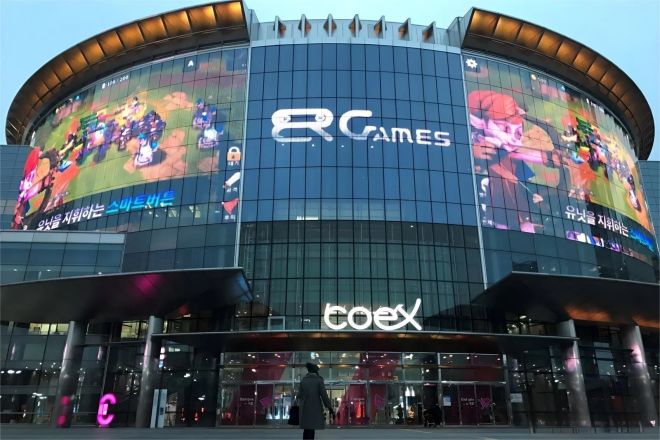
As the new favorite of outdoor advertising, transparent LED displays are widely used in streets, alleys, traffic arteries, and other locations, and they have a unique visual appeal and high flexibility.
They can not only effectively convey advertising information but also integrate with the surrounding environment, reduce visual pollution, and enhance the beauty of the city.
2). Technical challenges and solutions
- 방수 및 방진:
The outdoor environment places strict requirements on the waterproof and dustproof performance of the display. The solution includes a well-sealed shell design combined with professional waterproof rubber rings and dustproof filters to ensure that the display can still operate stably in bad weather.
- Anti-ultraviolet:
Long-term exposure to ultraviolet rays will cause the display material to age and the color to fade. Using materials with excellent UV resistance, such as UV protective coatings or special polymers, can effectively extend the service life of the display.
- 내후성:
In order to cope with natural environmental factors such as temperature changes and humidity fluctuations, the display needs to have good weather resistance.
This requires the selection of electronic components that can work stably in extreme environments, and the use of scientific heat dissipation design and temperature control mechanisms.
- Display effect and stability:
By optimizing the arrangement of LED chips, improving color reproduction and contrast, and using advanced image processing technology, the display effect of outdoor transparent LED displays can be significantly improved.
At the same time, strengthening the heat dissipation design and regular maintenance is also key to ensuring the long-term stability of the display.
3). Visual impact
The reason why outdoor transparent LED displays can stand out among many media is largely due to their unique visual effects. These displays can cleverly integrate into the surrounding environment and create a shocking visual impact through dynamic and colorful picture displays.
They can not only attract the attention of pedestrians and increase brand exposure but also enhance the city’s image and cultural connotation through artistic expression techniques.
For example, setting up a transparent LED display in a city square and playing short films or patterns related to the city’s history and culture can deepen citizens’ and tourists’ understanding and recognition of the city.
2. 3 aspects to quickly understand indoor transparent LED display screens
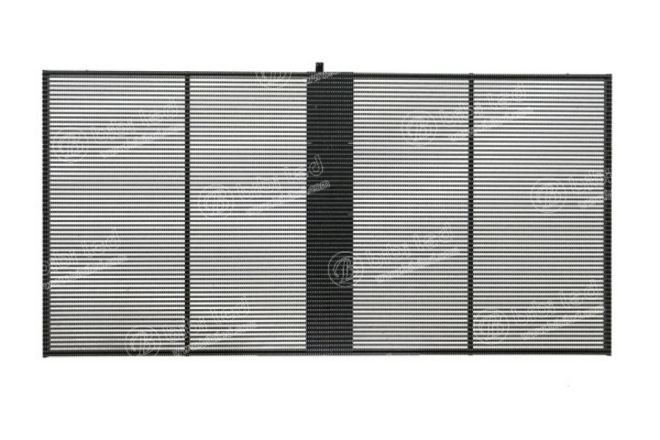
1). 적용 시나리오
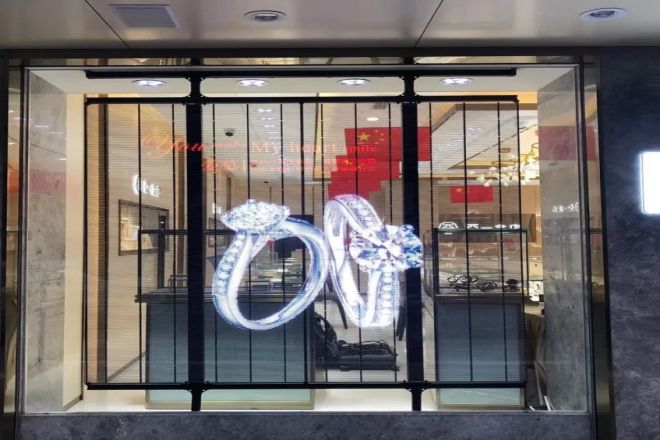
- Retail store window display:
The application of indoor transparent LED display screens in retail store windows brings a new dimension to product display.
They can not only dynamically display product features and promotional activities, but also echo the internal space of the store to create a shopping atmosphere that is more attractive to customers.
The transparent design allows customers to clearly see the goods displayed in the store outside the store, which increases the fun and convenience of shopping.
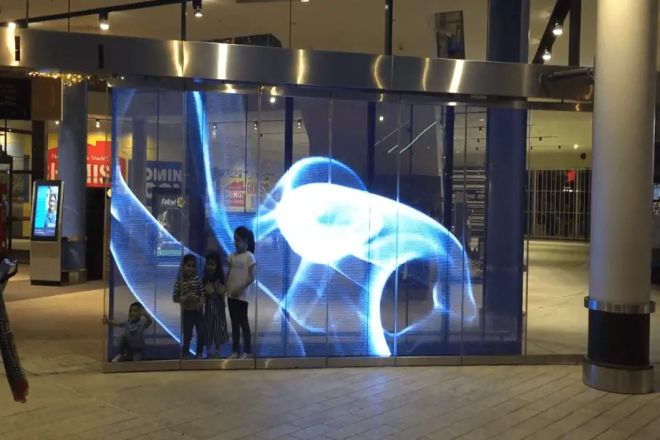
In museum exhibitions, indoor transparent LED display screens play an important role as a tool for information display and auxiliary display of artworks.
They can play historical background introductions, cultural relics restoration processes, scientific principle explanations and other content to provide visitors with a richer visiting experience.
At the same time, the transparent design allows the display screen to integrate with the exhibition environment, without destroying the original display effect of the exhibits, and enhances the integrity and beauty of the exhibition.
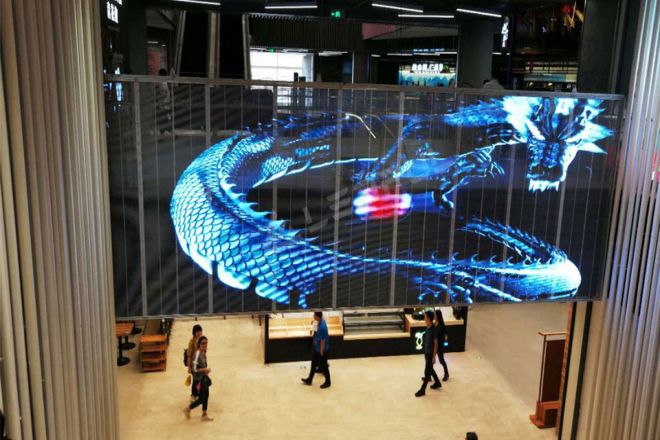
- 호텔 lobby decoration:
The hotel lobby is an important place to show the hotel’s taste and image.
The application of an indoor transparent LED display screen here can not only serve as a platform for information release, display hotel services, activities, and other information, but also as a decorative element, creating a warm and elegant atmosphere by playing artistic patterns, natural scenery, and other content.
The transparent design makes the display screen complement the decoration style of the lobby, enhancing the beauty and grade of the overall space.
2). Design aesthetics
The design aesthetics of the indoor transparent LED display screen is reflected in its ability to cleverly integrate into the interior decoration to achieve a perfect combination of technology and art.
Designers can customize the appropriate display screen size, shape, and installation method according to factors such as space style, color matching, and light conditions.
The lightness and transparency of transparent display screens enable them to become part of the interior decoration rather than an abrupt existence.
By playing content that is coordinated with the atmosphere of the space, the beauty and interactivity of the space can be further enhanced, allowing the audience to enjoy the information while enjoying the visual pleasure.
3). Viewing experience
In indoor environments, the audience has higher requirements for color reproduction, viewing angle, and brightness adjustment.
In order to enhance the viewing experience of the audience, the indoor transparent LED display screen has made a number of technical optimizations:
- Color reproduction:
The use of high color gamut LED chips and advanced color management technology ensures that the display screen can accurately restore the true color of the image, allowing the audience to experience a more realistic and vivid visual effect.
- 시야각:
By optimizing the arrangement and packaging process of LED chips and adopting technical means such as wide-angle lenses, the viewing angle range of the display screen is expanded to ensure that the audience can get a clear viewing effect at different positions.
- 명도 조정:
Automatically adjust the brightness of the display screen according to indoor light conditions and audience needs. Reduce the brightness in a dark environment to reduce glare; increase the brightness in a bright environment to ensure the viewing effect.
In addition, the automatic brightness adjustment function can be achieved through intelligent sensing technology to enhance the audience’s comfort and viewing experience.
3. Comparative analysis of outdoor and indoor transparent LED display screens
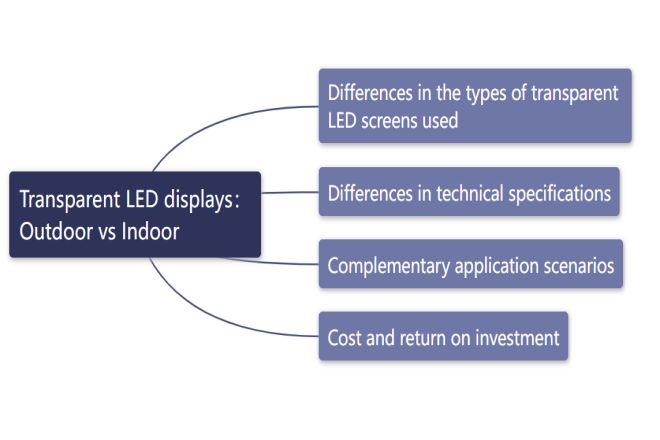
1). Differences in the types of LED transparent screens used
- Indoor transparent LED display screens:
Usually, non-waterproof LED transparent screens are selected, and their protection level is relatively low, focusing on the balance between transparency and display effect.
This type of screen design focuses more on the decorative and information display functions of the indoor environment and does not require high waterproof performance.
- Outdoor transparent LED display:
You must use an LED grille screen with a high protection level, such as products that meet the IP65 standard. This screen can withstand harsh outdoor environments, such as rain, wind, and sand, and ensure stable operation under complex and changeable weather conditions.
2). Technical specification differences
There are significant differences between indoor and outdoor transparent LED displays in terms of technical specifications. The following is a detailed comparative analysis:
2.1). Brightness
- Indoor transparent LED display:
Since the indoor ambient light is relatively weak, its brightness requirement is relatively low, generally between 1000-2000cd/㎡.
This brightness range is sufficient to meet indoor viewing needs while maintaining low energy consumption.
- Outdoor transparent LED display:
The outdoor ambient light is strong, especially when the sun is directly shining, and the brightness of the display is extremely high.
Therefore, the brightness of outdoor transparent LED displays is usually above 2000-5000cd/㎡and can even reach 10,000 nits. Such high brightness can ensure that the picture is still clearly visible under strong outdoor light.
2.2). 해결
- Indoor transparent LED display:
Since the indoor viewing distance is close and there are often high requirements for detail display, the resolution of indoor transparent LED display is usually higher.
High resolution can support fine image and text display and improve the viewing experience.
- Outdoor transparent LED display:
Although the resolution of outdoor display is also affected by pixel pitch, in general, its resolution is relatively low. This is mainly because the outdoor viewing distance is far, and too high resolution is difficult to be clearly identified at a long distance.
However, with the advancement of technology, the resolution of outdoor display screens is also constantly improving to meet the viewing needs of longer distances.
2.3). Transparency
- Indoor transparent LED display:
The transparency of indoor transparent LED display is usually high to maintain the transparency of interior decoration.
High transparency can reduce the screen’s obstruction of indoor light while integrating with the indoor environment and enhancing the overall beauty.
- Outdoor transparent LED display:
The transparency of outdoor transparent LED display is moderate, and a balance needs to be struck between transparency and display effect.
Too high transparency may sacrifice the display effect, while too low transparency may affect the transparency of the screen. Therefore, various factors need to be considered comprehensively when designing outdoor transparent LED displays.
2.4). Protection level
- Indoor transparent LED display:
Due to the relatively mild indoor environment, the protection level requirements for the display are relatively low. Therefore, indoor transparent LED display screens usually do not have or only have low protection levels, such as waterproof and dustproof.
- Outdoor transparent LED display screen:
The outdoor environment is complex and changeable, and the protection level requirements for the display screen are extremely high.
Outdoor transparent LED display screens must have a high protection level, such as IP65 or above, to ensure stable operation under severe weather conditions (such as rain, wind, sand, etc.).
3). Complementary application scenarios
- Indoor transparent LED display screen:
Suitable for retail store windows, 박물관 exhibitions, 호텔 lobbies, conference and exhibition centers, and other places that require fine display and decorative effects.
Its high transparency and high resolution can enhance the visual beauty of indoor space while achieving effective communication of information.
- Outdoor transparent LED display screen:
It is widely used in outdoor spaces such as urban squares, commercial centers, and stadiums as an important part of advertising, information release, and night landscape.
Its high brightness and high protection level ensure clear display and stable operation of information in outdoor environments.
The two complement each other in application scenarios and jointly build a diversified visual experience.
4). Cost and Return on Investment
- Cost investment:
The outdoor transparent LED display screen has a relatively high cost because it requires higher brightness, stronger protection level and larger size. Indoor transparent LED display screens are relatively cheaper.
- Installation difficulty:
The installation of outdoor transparent LED display screens needs to consider more environmental factors, such as wind, rain, etc., so the installation is relatively difficult.
At the same time, in order to ensure the stability and safety of the screen, professional structural design and construction are also required. The installation of indoor transparent LED display screens is relatively simple.
- 유지 보수 비용:
The maintenance cost of outdoor transparent LED display screens is also relatively high, and regular maintenance work such as waterproofing, dustproofing, and corrosion prevention is required. Indoor transparent LED display screens are relatively easy to maintain.
- Long-term return on investment:
Although the initial investment in outdoor transparent LED display screens is large, its advertising effect and brand promotion value are also higher, which can attract more attention.
Therefore, in the long run, its return on investment may be more significant. Indoor transparent LED display screens focus more on improving the quality and atmosphere of indoor space, and its return on investment is mainly reflected in improving customer experience and brand image.
4. What is the development trend of transparent LED display screens in the future?
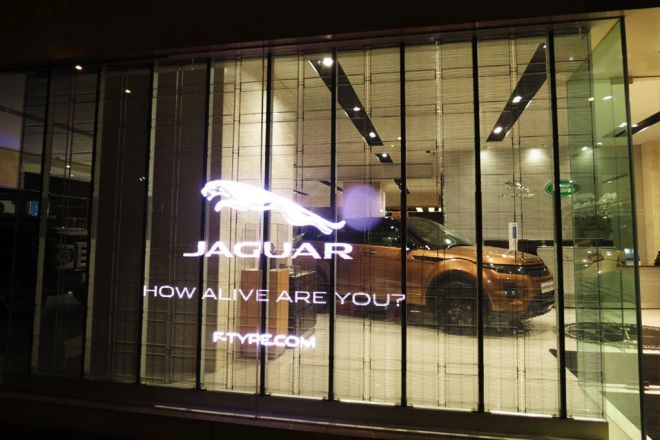
1). Material science:
New luminescent materials: With the advancement of material science, transparent LED displays may use more efficient luminescent materials in the future, such as perovskite LEDs, which have significant advantages in improving brightness and luminous efficiency.
Flexible materials: Flexible transparent LED displays will become one of the development trends, which can adapt to the installation requirements of various complex shapes and broaden the application field.
2). Display technology:
High resolution and high contrast: With the continuous advancement of technology, the resolution and contrast of transparent LED displays will continue to improve, providing users with a clearer and more delicate visual experience.
Color management: Color management technology will become more mature, allowing transparent LED displays to restore colors more accurately and meet the needs of high-end application scenarios.
3). Intelligent control:
Internet of Things and Intelligence: Transparent LED displays will be deeply integrated with Internet of Things technology to realize functions such as remote monitoring and intelligent adjustment and improve operation and maintenance efficiency.
Human-computer interaction: Combined with new technologies such as AR/VR, transparent LED displays will achieve a richer human-computer interaction experience and provide users with more immersive visual enjoyment.
결론
With the continuous advancement of technology and the continuous expansion of applications, transparent LED displays are changing our visual world at an unprecedented speed.
From large outdoor billboards to exquisite indoor decorations, they tell brand stories and convey cultural values in a unique way while also adding new dimensions to urban landscapes and architectural aesthetics.
마지막으로 LED 디스플레이에 대해 더 알고 싶으시다면, 우리에게 연락해주세요.
